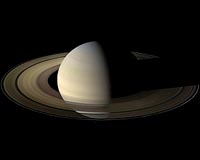|
|
|
A Long Night Falls Over Saturn's Rings Greenbelt MD (SPX) Oct 26, 2009  As Saturn's rings orbit the planet, a section is typically in the planet's shadow, experiencing a brief night lasting from 6 to 14 hours. However, once approximately every 15 years, night falls over the entire visible ring system for about four days. This happens during Saturn's equinox, when the sun is directly over Saturn's equator. At this time, the rings, which also orbit directly over ... read more
As Saturn's rings orbit the planet, a section is typically in the planet's shadow, experiencing a brief night lasting from 6 to 14 hours. However, once approximately every 15 years, night falls over the entire visible ring system for about four days. This happens during Saturn's equinox, when the sun is directly over Saturn's equator. At this time, the rings, which also orbit directly over ... read moreGalaxy Cluster Smashes Distance Record  Boston MA (SPX) Oct 26, 2009
Boston MA (SPX) Oct 26, 2009The most distant galaxy cluster yet has been discovered by combining data from NASA's Chandra X-ray Observatory and optical and infrared telescopes. The cluster is located about 10.2 billion light years away, and is observed as it was when the Universe was only about a quarter of its present age. The galaxy cluster, known as JKCS041, beats the previous record holder by about a billion ... more
|
Vietnam says parched Red River at record low
China to be world's third biggest wind power producer: media Cost-cutting NASA eyes three cheap space missions Honduras declares state of emergency amid drought Russia in secret plan to save Earth from asteroid: official Sarkozy scrambles to salvage carbon tax French carbon tax ruled illegal Brazil's Lula signs law cutting CO2 emissions 2009 a 'benign' year of natural disasters: German re-insurer Greenpeace Spain demands Denmark release its director
| |||||||||||||||
| Previous Issues | Oct 23 | Oct 22 | Oct 21 | Oct 20 | Oct 19 |
| . |
NASA Instruments Reveal Water Molecules On Lunar Surface Pasadena CA (SPX) Oct 26, 2009
Pasadena CA (SPX) Oct 26, 2009NASA scientists have discovered water molecules in the polar regions of the moon. Instruments aboard three separate spacecraft revealed water molecules in amounts that are greater than predicted, but still relatively small. Hydroxyl, a molecule consisting of one oxygen atom and one hydrogen atom, also was found in the lunar soil. The findings were published in Thursday's edition of the journal ... more NASA Mission To Study Moon's Fragile Atmosphere  Huntsville AL (SPX) Oct 26, 2009
Huntsville AL (SPX) Oct 26, 2009Right now, the Moon is a ghost town. Nothing stirs. Here and there, an abandoned Apollo rover - or the dusty base of a lunar lander - linger as silent testimony to past human activity. But these days, only occasional asteroid impacts disrupt the decades-long spell of profound stillness. And this stillness presents scientists with an important opportunity. Currently, the Moon's ... more UK Science Benefits From High Performance Computing Investment  London, UK (SPX) Oct 22, 2009
London, UK (SPX) Oct 22, 2009The Science and Technology Facilities Council (STFC) has received Pounds 12.32 million, from the Government's Large Facilities Capital Fund, to invest in new hardware for the UK's High Performance Computing Consortia (HPC) - providing UK particle physicists and astronomers with upgraded HPC technology to address some of the most challenging scientific problems. The new funding will allow ... more |
. |
| . |
Scientists Use Supercomputers To 'See' Black Holes Rochester NY (SPX) Oct 21, 2009
Rochester NY (SPX) Oct 21, 2009Scientists at Rochester Institute of Technology have won several grants to further extend their own supercomputer and make use of two of the fastest supercomputers in the world in their quest to "shine light" on black holes. Since light cannot escape from the surface of a black hole, scientists rely upon computer algorithms to study the massive dark objects. Researchers in the Center for ... more Astronomy Question Of The Week: What Does The 'Family Tree' Of Stars Look Like  Bonn, Germany (SPX) Oct 21, 2009
Bonn, Germany (SPX) Oct 21, 2009Not all of the stars in the Universe are the same - differences in brightness and colour can be recognised even with the naked eye. In the 19th century, star spectroscopy developed into an important method of analysis in astronomy: it divides light and other electromagnetic radiation from stars according to its wavelength. For example, visible light is split into the colours of the rainbow ... more 32 New Exoplanets Found  Paris, France (SPX) Oct 20, 2009
Paris, France (SPX) Oct 20, 2009At the international ESO/CAUP exoplanet conference in Porto, the team who built the High Accuracy Radial Velocity Planet Searcher, better known as HARPS, the spectrograph for ESO's 3.6-metre telescope, have reported on the incredible discovery of some 32 new exoplanets, cementing HARPS's position as the world's foremost exoplanet hunter. This result also increases the number of known ... more |
. |
| Previous Issues | Oct 23 | Oct 22 | Oct 21 | Oct 20 | Oct 19 |
| The contents herein, unless otherwise known to be public domain, are Copyright 1995-2009 - SpaceDaily. AFP and UPI Wire Stories are copyright Agence France-Presse and United Press International. ESA Portal Reports are copyright European Space Agency. All NASA sourced material is public domain. Additional copyrights may apply in whole or part to other bona fide parties. Advertising does not imply endorsement, agreement or approval of any opinions, statements or information provided by SpaceDaily on any web page published or hosted by SpaceDaily. Privacy statement |